|
White-breasted Nuthatch / Sittelle à poitrine blanche (Sitta carolinensis) |
 |
Introductory notes:
While sexes are easily separated by the colour of the crown, age can be difficult to determine. Unlike most North American passerines, HY/SY White-breasted Nuthatches have no distinct molt limits on the wings, and tail shape/condition does not vary appreciably by age either. Overall appearance of the wing can be used to assess age, but with caution, especially when very fresh or worn. |
QUICK TIPS:
| 1) Look
at the crown - it is black on males, but a duller dark gray on females
2) Check the edging of feathers on the wing - on AHY/ASY birds most feathers have distinct blue-gray edging, on HY/SY males there is narrower blue-gray edging, and HY/SY females tend to have narrow brownish edging
3) Consider the overall quality of the wing - HY/SY birds have juvenile feathers that tend to be somewhat duller and more abraded especially by spring, while AHY/SY birds have a more uniformly dark and fresh wing |
Species account updated February 2011 |
Ageing and sexing overview:
Ageing and sexing details:
|
JAN - JUL: after-second-year
male |
Males of any age can usually be readily recognized by having a solid black cap, but age is not as easy to determine at a glance, and usually requires close examination of the open wing.
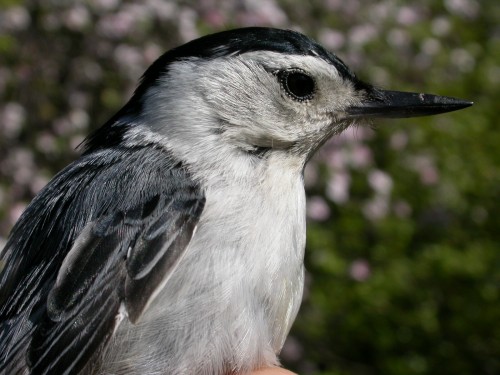
Photo by Marcel Gahbauer,
McGill Bird Observatory (QC), May 2005
AHY males have a uniformly dark wing with bluish-gray edging to their greater coverts, primary coverts, primaries, and secondaries.
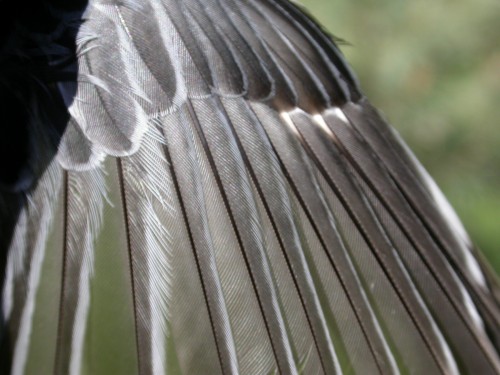
A closeup highlighting the bluish-gray edging to feathers on the wing.
Photo by Marcel Gahbauer,
May 2005
Shape, colour, and condition of rectrices differs relatively little by age and sex in White-breasted Nuthatches, and therefore the tail is generally not useful for identification.
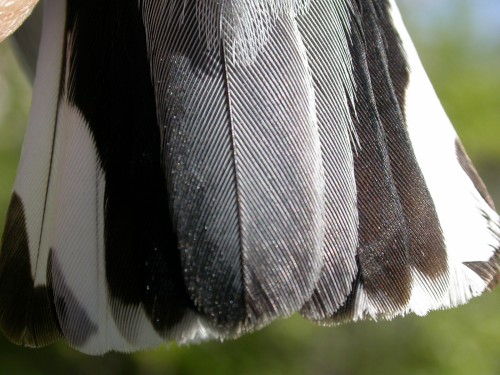
Photo by Marcel Gahbauer,
May 2005
RETURN TO AGE/SEX
OVERVIEW
|
JAN - JUL: after-second-year
female |
Females of any age can be distinguished from males by their gray rather than black crown, but as with males, ageing requires a careful look at the open wing.
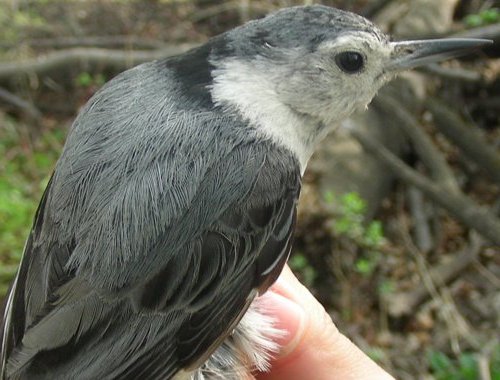
Photo by Marcel Gahbauer, Inglewood Bird Sanctuary (AB), May 2008
AHY females have a uniformly gray wing with pale gray edging to the greater coverts, primary coverts, primaries, and secondaries.
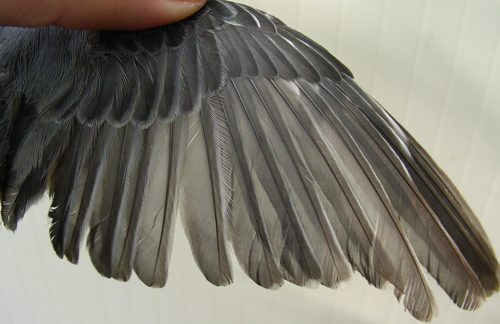
Photo by Marcel Gahbauer, Inglewood Bird Sanctuary (AB), May 2008
Shape, colour, and condition of rectrices differs relatively little by age and sex in White-breasted Nuthatches, and therefore the tail is generally not useful for identification.
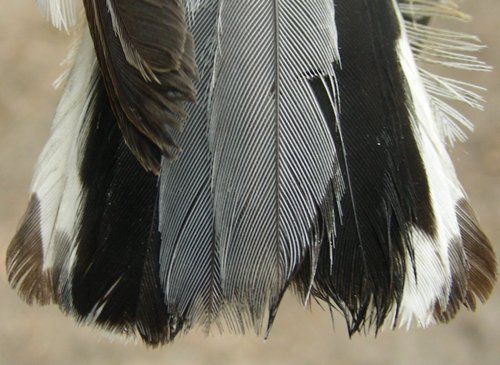
Photo by Marcel Gahbauer, Inglewood Bird Sanctuary (AB), May 2008
RETURN TO AGE/SEX
OVERVIEW
|
JAN - JUL: second-year
male |
SY males generally look the same as older males, with the wing usually providing the only means of distinguishing age.
SY males can best be aged by the wing, but since the preformative molt is usually very limited (i.e. on the wing only some lesser coverts are replaced), molt limits are typically not obvious, and judging the condition of the wing can be difficult. Generally though SY males have somewhat browner wings than ASY individuals, with less bluish-gray edging on the greater coverts, primary coverts, primaries, and secondaries.
Shape, colour, and condition of rectrices differs relatively little by age and sex in White-breasted Nuthatches, and therefore the tail is generally not useful for identification.
RETURN TO AGE/SEX
OVERVIEW
|
JAN - JUL: second-year
female |
SY females generally look the same as older females, with the wing usually providing the only means of distinguishing age.
As with males, SY females have undergone a very limited preformative molt, limited on the wing to only some lesser coverts. However, the overall appearance of the wing can still be helpful for ageing, in that it is quite brownish on SY females, with limited edging on the greater coverts, primary coverts, primaries, and secondaries, but where edging does occur, it tends to be more brownish, rather than the grayish of ASY females.
Shape, colour, and condition of rectrices differs relatively little by age and sex in White-breasted Nuthatches, and therefore the tail is generally not useful for identification.
RETURN TO AGE/SEX
OVERVIEW
|
JUL - DEC: after-hatch-year
male |
Male White-breasted Nuthatches are easily recgonized by their black crowns. Age can generally be distinguished only by wing; even skull can be tricky with this species as adults may retain some "windows".
AHY males have a uniformly dark wing with distinct blue-gray edging to the greater coverts, primary coverts, primaries, and secondaries.
Shape, colour, and condition of rectrices differs relatively little by age and sex in White-breasted Nuthatches, and therefore the tail is generally not useful for identification.
RETURN TO AGE/SEX
OVERVIEW
|
JUL - DEC: after-hatch-year
female |
Female White-breasted Nuthatches are easily recognized by their gray, rather than black, crowns. Age can generally be distinguished only by wing; even skull can be tricky with this species as adults may retain some "windows".
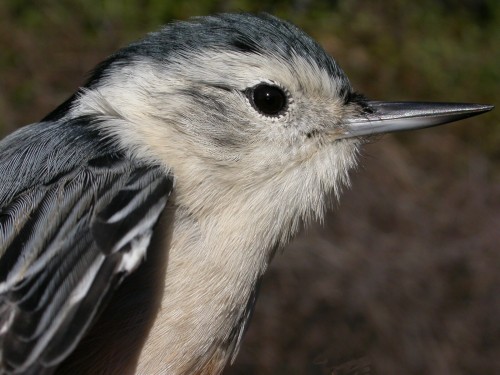
Photo by Marcel Gahbauer,
October 2005
Like males, AHY females have a uniformly dark wing with distinct blue-gray edging to the greater coverts, primary coverts, primaries, and secondaries.
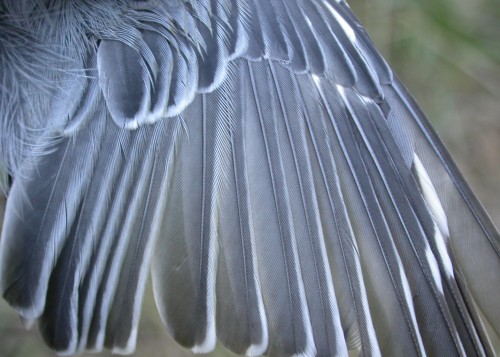
Photo by Marcel Gahbauer,
October 2005
Shape, colour, and condition of rectrices differs relatively little by age and sex in White-breasted Nuthatches, and therefore the tail is generally not useful for identification.
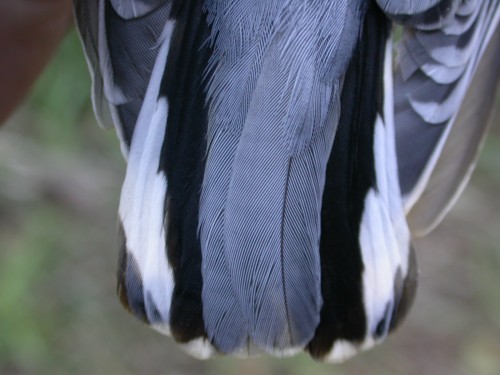
Photo by Marcel Gahbauer,
October 2005
RETURN TO AGE/SEX
OVERVIEW
|
JUL - DEC: hatch-year
male |
HY males are largely identical to AHY males in overall appearance, but there may be subtle differences evident upon close examination of the wing.
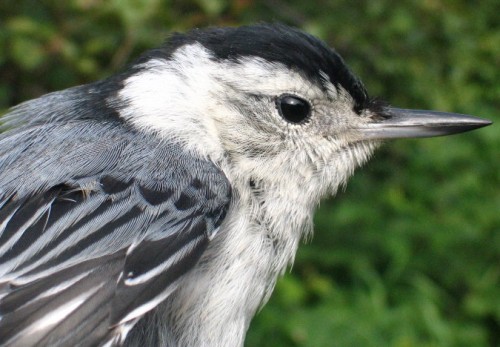
Photo by Seabrooke Leckie,
August 2006
HY males have a dark wing, with somewhat less blue edging to the feathers than AHY individuals, especially on the primary coverts. However, the distinction is subtle, and especially when feathers are fresh (late summer / early fall), males may be difficult to age by plumage. During this period, the skull development of HY individuals is far more limited than that of AHY nuthatches, and that is the most reliable indicator of age.
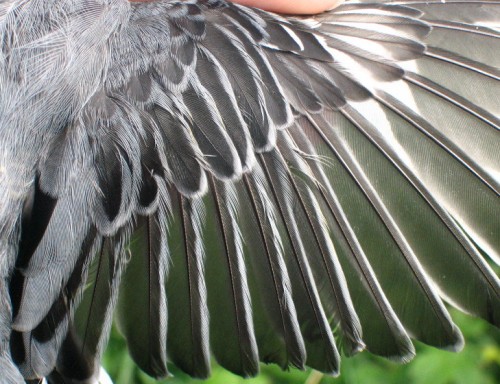
Photo by Seabrooke Leckie,
August 2006
Shape, colour, and condition of rectrices differs relatively little by age and sex in White-breasted Nuthatches, and therefore the tail is generally not useful for identification.
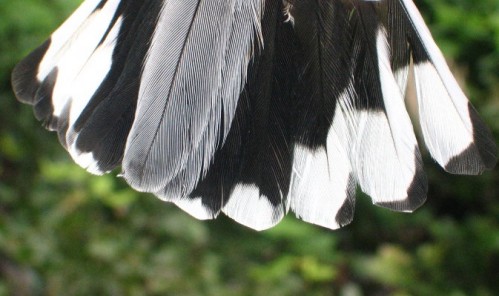
Photo by Seabrooke Leckie,
August 2006
RETURN TO AGE/SEX
OVERVIEW
|
JUL - DEC: hatch-year
female |
HY females are largely identical to AHY females in overall appearance, but tend to be somewhat browner on the wing, which may be visible to some extent on a perched individual.
HY females have a dull wing, usually with some faint brownish tinges, especially along the edges of the primaries and secondaries.
Shape, colour, and condition of rectrices differs relatively little by age and sex in White-breasted Nuthatches, and therefore the tail is generally not useful for identification.
RETURN TO AGE/SEX
OVERVIEW
|